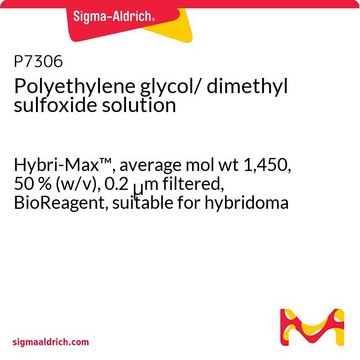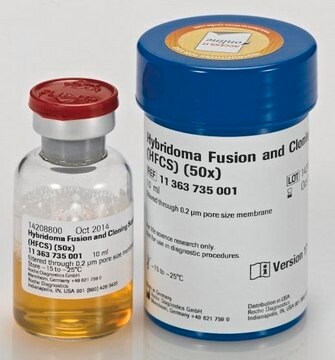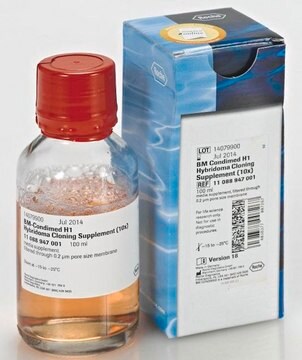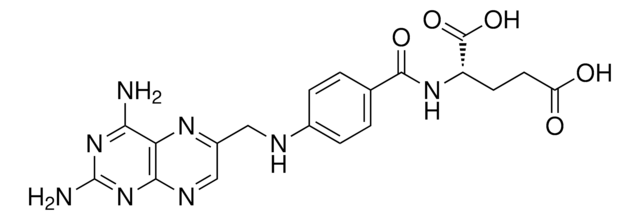P7181
Polyethylene glycol solution
Hybri-Max™, 50 % (w/v), average mol wt 1,450, 0.2 μm filtered, BioReagent, suitable for hybridoma
Sinónimos:
PEG Solution, Polyethylene Glycol
About This Item
Productos recomendados
grado
Hybri-Max™
Nivel de calidad
esterilidad
0.2 μm filtered
Línea del producto
BioReagent
formulario
solution
mol peso
average mol wt 1,450
concentración
50 % (w/v)
técnicas
cell culture | hybridoma: suitable
impurezas
endotoxin, tested
temp. de almacenamiento
2-8°C
cadena SMILES
C(CO)O
InChI
1S/C2H6O2/c3-1-2-4/h3-4H,1-2H2
Clave InChI
LYCAIKOWRPUZTN-UHFFFAOYSA-N
Categorías relacionadas
Descripción general
Aplicación
- irradiated camel fibroblast cells with A23 hamster cells
- mouse splenocytes with Sp2/0-Ag 14 mouse myeloma cells
- rabbit splenocytes and cell line 240E-1
PEG is used as a fusogen to obtain hybridomas for monoclonal antibody production. Induces cell hybridization.
Acciones bioquímicas o fisiológicas
Envase
Otras notas
Reconstitución
Información legal
Código de clase de almacenamiento
10 - Combustible liquids
Clase de riesgo para el agua (WGK)
WGK 1
Punto de inflamabilidad (°F)
212.0 °F - closed cup
Punto de inflamabilidad (°C)
100 °C - closed cup
Equipo de protección personal
Eyeshields, Faceshields, Gloves, type ABEK (EN14387) respirator filter
Certificados de análisis (COA)
Busque Certificados de análisis (COA) introduciendo el número de lote del producto. Los números de lote se encuentran en la etiqueta del producto después de las palabras «Lot» o «Batch»
¿Ya tiene este producto?
Encuentre la documentación para los productos que ha comprado recientemente en la Biblioteca de documentos.
Los clientes también vieron
Nuestro equipo de científicos tiene experiencia en todas las áreas de investigación: Ciencias de la vida, Ciencia de los materiales, Síntesis química, Cromatografía, Analítica y muchas otras.
Póngase en contacto con el Servicio técnico




